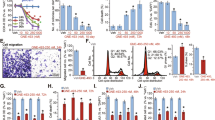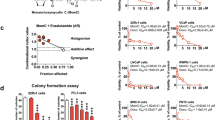Abstract
Recent studies indicate that natural isothiocyanates, such as sulforaphane (SFN) and phenethyl isothiocyanate (PEITC) possess strong antitumor activities in vitro and in vivo. The nuclear factor kappa B (NF-κB) is believed to play an important role in cancer chemoprevention due to its involvement in tumor cell growth, proliferation, angiogenesis, invasion, apoptosis, and survival. In this study, we investigated the effects and the molecular mechanisms of SFN and PEITC on NF-κB transcriptional activation and NF-κB-regulated gene expression in human prostate cancer PC-3 C4 cells. Treatment with SFN (20 and 30 μ M) and PEITC (5 and 7.5 μ M) significantly inhibited NF-κB transcriptional activity, nuclear transloction of p65, and gene expression of NF-κB-regulated VEGF, cylcin D1, and Bcl-XL in PC-3 C4 cells. To further elucidate the mechanism, we utilized the dominant-negative mutant of inhibitor of NF-κB alpha (IκBα) (SR-IκBα). Analogous to treatments with SFN and PEITC, SR-IκBα also strongly inhibited NF-κB transcriptional activity as well as VEGF, cylcin D1, and Bcl-XL expression. Furthermore, SFN and PEITC also inhibited the basal and UVC-induced phosphorylation of IκBα and blocked UVC-induced IκBα degradation in PC-3 C4 cells. In examining the upstream signaling, we found that the dominant-negative mutant of IKKβ (dnIKKβ) possessed inhibitory effects similar to SFN and PEITC on NF-κB, VEGF, cylcin D1, Bcl-XL as well as IκBα phosphorylation. In addition, treatment with SFN and PEITC potently inhibited phosphorylation of both IKKβ and IKKα and significantly inhibited the in vitro phosphorylation of IκBα mediated by IKKβ. Taken together, these results suggest that the inhibition of SFN and PEITC on NF-κB transcriptional activation as well as NF-κB-regulated VEGF, cyclin D1, and Bcl-XL gene expression is mainly mediated through the inhibition of IKK phosphorylation, particularly IKKβ, and the inhibition of IκBα phosphorylation and degradation, as well as the decrease of nuclear translocation of p65 in PC-3 cells.
This is a preview of subscription content, access via your institution
Access options
Subscribe to this journal
Receive 50 print issues and online access
$259.00 per year
only $5.18 per issue
Buy this article
- Purchase on Springer Link
- Instant access to full article PDF
Prices may be subject to local taxes which are calculated during checkout







Similar content being viewed by others
Abbreviations
- ITC:
-
isothiocyanate
- SFN:
-
sulforaphane
- PEITC:
-
phenethyl isothiocyanate
- NF-κB:
-
nuclear factor kappa B
- IκBα:
-
inhibitor of NF-κB alpha
- IKK:
-
IκB kinase
- VEGF:
-
vascular endothelial growth factor
References
Aggarwal BB, Takada Y, Shishodia S, Gutierrez AM, Oommen OV, Ichikawa H, Baba Y and Kumar A . (2004). Indian J. Exp. Biol., 42, 341–353.
Amit S and Ben-Neriah Y . (2003). Semin. Cancer Biol., 13, 15–28.
Bremner P and Heinrich M . (2002). J. Pharm. Pharmacol., 54, 453–472.
Brooks JD and Paton V . (1999). Prostate Cancer Prostatic Dis., 2, S8.
Brooks JD, Paton VG and Vidanes G . (2001). Cancer Epidemiol. Biomarkers Prev., 10, 949–954.
Catley MC, Cambridge LM, Nasuhara Y, Ito K, Chivers JE, Beaton A, Holden NS, Bergmann MW, Barnes PJ and Newton R . (2004). J. Biol. Chem., 279, 18457–18466.
Chen YR, Han J, Kori R, Kong AN and Tan TH . (2002). J. Biol. Chem., 277, 39334–39342.
Chiao JW, Chung FL, Kancherla R, Ahmed T, Mittelman A and Conaway CC . (2002). Int. J. Oncol., 20, 631–636.
Chung FL, Conaway CC, Rao CV and Reddy BS . (2000). Carcinogenesis, 21, 2287–2291.
Cohen JH, Kristal AR and Stanford JL . (2000). J. Natl. Cancer Inst., 92, 61–68.
Fan C, Li Q, Ross D and Engelhardt JF . (2003). J. Biol. Chem., 278, 2072–2080.
Gasparian AV, Yao YJ, Kowalczyk D, Lyakh LA, Karseladze A, Slaga TJ and Budunova IV . (2002a). J. Cell Sci., 115, 141–151.
Gasparian AV, Yao YJ, Lu J, Yemelyanov AY, Lyakh LA, Slaga TJ and Budunova IV . (2002b). Mol. Cancer Ther., 1, 1079–1087.
Greten FR and Karin M . (2004). Cancer Lett., 206, 193–199.
Hecht SS . (2000). Drug Metab. Rev., 32, 395–411.
Heiss E, Herhaus C, Klimo K, Bartsch H and Gerhauser C . (2001). J. Biol. Chem., 276, 32008–32015.
Henttu P and Vihko P . (1998). Biochem. Biophys. Res. Commun., 244, 167–171.
Holmes-McNary M and Baldwin Jr. AS . (2000). Cancer Res., 60, 3477–3483.
Hu R, Hebbar V, Kim BR, Chen C, Winnik B, Buckley B, Soteropoulos P, Tolias P, Hart RP and Kong AN . (2004). J. Pharmacol. Exp. Ther., 310, 263–271.
Huang S, Pettaway CA, Uehara H, Bucana CD and Fidler IJ . (2001). Oncogene, 20, 4188–4197.
Jeong WS, Kim IW, Hu R and Kong AN . (2004). Pharm. Res., 21, 661–670.
Kolonel LN, Hankin JH, Whittemore AS, Wu AH, Gallagher RP, Wilkens LR, John EM, Howe GR, Dreon DM, West DW and Paffenbarger Jr RS . (2000). Cancer Epidemiol. Biomarkers Prev., 9, 795–804.
Kong AN, Yu R, Hebbar V, Chen C, Owuor E, Hu R, Ee R and Mandlekar S . (2001). Mutat. Res., 480–481, 231–241.
Manna SK, Mukhopadhyay A, Van NT and Aggarwal BB . (1999). J. Immunol., 163, 6800–6809.
Mathas S, Lietz A, Janz M, Hinz M, Jundt F, Scheidereit C, Bommert K and Dorken B . (2003). Blood, 102, 1028–1034.
Nomura M, Ma W, Chen N, Bode AM and Dong Z . (2000). Carcinogenesis, 21, 1885–1890.
O'Mahony A, Lin X, Geleziunas R and Greene WC . (2000). Mol. Cell Biol., 20, 1170–1178.
Rayet B and Gelinas C . (1999). Oncogene, 18, 6938–6947.
Senftleben U, Cao Y, Xiao G, Greten FR, Krahn G, Bonizzi G, Chen Y, Hu Y, Fong A, Sun SC and Karin M . (2001). Science, 293, 1495–1499.
Shukla S and Gupta S . (2004). Clin. Cancer Res., 10, 3169–3178.
Singh AV, Xiao D, Lew KL, Dhir R and Singh SV . (2004). Carcinogenesis, 25, 83–90.
Srivastava SK and Singh SV . (2004). Carcinogenesis, 25, 1701–1709.
Steinmetz KA and Potter JD . (1996). J. Am. Diet Assoc., 96, 1027–1039.
Suh J, Payvandi F, Edelstein LC, Amenta PS, Zong WX, Gelinas C and Rabson AB . (2002). Prostate, 52, 183–200.
Suh J and Rabson AB . (2004). J. Cell Biochem., 91, 100–117.
Takada Y and Aggarwal BB . (2004). J. Biol. Chem., 279, 4750–4759.
Takada Y, Khuri FR and Aggarwal BB . (2004a). J. Biol. Chem., 279, 26287–26299.
Takada Y, Mukhopadhyay A, Kundu GC, Mahabeleshwar GH, Singh S and Aggarwal BB . (2003). J. Biol. Chem., 278, 24233–24241.
Takada Y, Singh S and Aggarwal BB . (2004b). J. Biol. Chem., 279, 15096–15104.
Talalay P and Fahey JW . (2001). J. Nutr., 131, 3027S–3033S.
Willis MS and Wians FH . (2003). Clin. Chim. Acta., 330, 57–83.
Xiao D and Singh SV . (2002). Cancer Res., 62, 3615–3619.
Acknowledgements
We thank all the members of Dr Tony Kong's lab for their help in the preparation of this manuscript. Work described here was supported in part by institutional funds and Grant R01-CA073674 from the National Institutes of Health (NIH). We also acknowledge the support from NIH Grant R01-CA54999 to Dr Céline Gélinas.
Author information
Authors and Affiliations
Corresponding author
Rights and permissions
About this article
Cite this article
Xu, C., Shen, G., Chen, C. et al. Suppression of NF-κB and NF-κB-regulated gene expression by sulforaphane and PEITC through IκBα, IKK pathway in human prostate cancer PC-3 cells. Oncogene 24, 4486–4495 (2005). https://doi.org/10.1038/sj.onc.1208656
Received:
Revised:
Accepted:
Published:
Issue Date:
DOI: https://doi.org/10.1038/sj.onc.1208656
Keywords
This article is cited by
-
Novel molecules as the emerging trends in cancer treatment: an update
Medical Oncology (2022)
-
Selenium-enriched Bacillus subtilis reduces the effects of mercury-induced on inflammation and intestinal microbes in carp (Cyprinus carpio var. specularis)
Fish Physiology and Biochemistry (2022)
-
Sulforaphane as a Promising Natural Molecule for Cancer Prevention and Treatment
Current Medical Science (2021)
-
Natural products as promising targets in glioblastoma multiforme: a focus on NF-κB signaling pathway
Pharmacological Reports (2020)
-
Dietary phytochemicals in breast cancer research: anticancer effects and potential utility for effective chemoprevention
Environmental Health and Preventive Medicine (2018)



